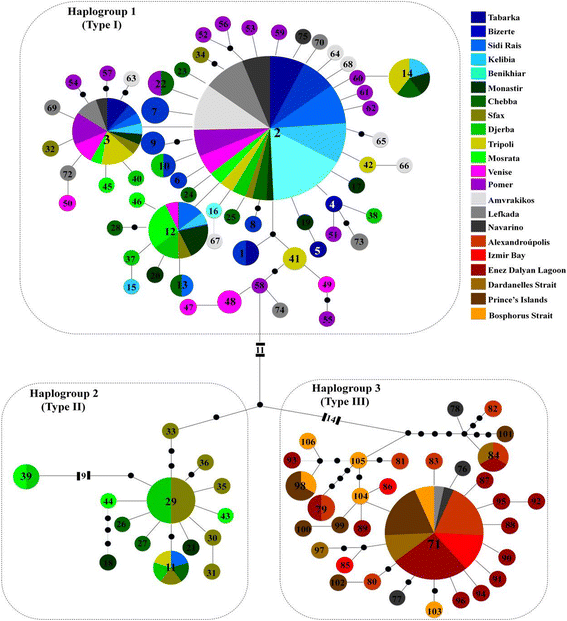Parapatric genetic divergence among deep evolutionary lineages in the Mediterranean green crab, Carcinus aestuarii (Brachyura, Portunoidea, Carcinidae), accounts for a sharp phylogeographic break in the Eastern Mediterranean
- PMID: 29642852
- PMCID: PMC5896055
- DOI: 10.1186/s12862-018-1167-4
Parapatric genetic divergence among deep evolutionary lineages in the Mediterranean green crab, Carcinus aestuarii (Brachyura, Portunoidea, Carcinidae), accounts for a sharp phylogeographic break in the Eastern Mediterranean
Abstract
Background: Recently, population genetic studies of Mediterranean marine species highlighted patterns of genetic divergence and phylogeographic breaks, due to the interplay between impacts of Pleistocene climate shifts and contemporary hydrographical barriers. These factors markedly shaped the distribution of marine organisms and their genetic makeup. The present study is part of an ongoing effort to understand the phylogeography and evolutionary history of the highly dispersive Mediterranean green crab, Carcinus aestuarii (Nardo, 1847), across the Mediterranean Sea. Recently, marked divergence between two highly separated haplogroups (genetic types I and II) of C. aestuarii was discerned across the Siculo-Tunisian Strait, suggesting an Early Pleistocene vicariant event. In order to better identify phylogeographic patterns in this species, a total of 263 individuals from 22 Mediterranean locations were analysed by comparing a 587 basepair region of the mitochondrial gene Cox1 (cytochrome oxidase subunit 1). The examined dataset is composed of both newly generated sequences (76) and previously investigated ones (187).
Results: Our results unveiled the occurrence of a highly divergent haplogroup (genetic type III) in the most north-eastern part of the Mediterranean Sea. Divergence between the most distinct type III and the common ancestor of both types I and II corresponds to the Early Pleistocene and coincides with the historical episode of separation between types I and II. Our results also revealed strong genetic divergence among adjacent regions (separating the Aegean and Marmara seas from the remaining distribution zone) and confirmed a sharp phylogeographic break across the Eastern Mediterranean. The recorded parapatric genetic divergence, with the potential existence of a contact zone between both groups in the Ionian Sea and notable differences in the demographic history, suggest the likely impact of paleoclimatic events, as well as past and contemporary oceanographic processes, in shaping genetic variability of this species.
Conclusions: Our findings not only provide further evidence for the complex evolutionary history of the green crab in the Mediterranean Sea, but also stress the importance of investigating peripheral areas in the species' distribution zone in order to fully understand the distribution of genetic diversity and unravel hidden genetic units and local patterns of endemism.
Keywords: Biogeographic boundaries; Crustacea; Evolutionary history; Mediterranean Sea; Mitochondrial DNA; Population genetics.
Conflict of interest statement
Ethics approval and consent to participate
None of the sampled populations of
Consent for publication
Not applicable.
Competing interests
The authors declare that they have no competing interests.
Publisher’s Note
Springer Nature remains neutral with regard to jurisdictional claims in published maps and institutional affiliations.
Figures





Similar articles
-
Phylogeographic and evolutionary history analyses of the warty crab Eriphia verrucosa (Decapoda, Brachyura, Eriphiidae) unveil genetic imprints of a late Pleistocene vicariant event across the Gibraltar Strait, erased by postglacial expansion and admixture among refugial lineages.BMC Evol Biol. 2019 May 17;19(1):105. doi: 10.1186/s12862-019-1423-2. BMC Evol Biol. 2019. PMID: 31101005 Free PMC article.
-
Unravelling population genetic structure with mitochondrial DNA in a notional panmictic coastal crab species: sample size makes the difference.BMC Evol Biol. 2016 Jul 26;16:150. doi: 10.1186/s12862-016-0720-2. BMC Evol Biol. 2016. PMID: 27455997 Free PMC article.
-
Fluvial basin history in the northeastern Mediterranean region underlies dispersal and speciation patterns in the genus Dugesia (Platyhelminthes, Tricladida, Dugesiidae).Mol Phylogenet Evol. 2013 Mar;66(3):877-88. doi: 10.1016/j.ympev.2012.11.010. Epub 2012 Nov 24. Mol Phylogenet Evol. 2013. PMID: 23182762
-
Harbour Porpoises, Phocoena phocoena, in the Mediterranean Sea and Adjacent Regions: Biogeographic Relicts of the Last Glacial Period.Adv Mar Biol. 2016;75:333-358. doi: 10.1016/bs.amb.2016.08.006. Epub 2016 Sep 28. Adv Mar Biol. 2016. PMID: 27770989 Review.
-
Pillars of Hercules: is the Atlantic-Mediterranean transition a phylogeographical break?Mol Ecol. 2007 Nov;16(21):4426-44. doi: 10.1111/j.1365-294X.2007.03477.x. Epub 2007 Oct 1. Mol Ecol. 2007. PMID: 17908222 Review.
Cited by
-
Phylogeographic and evolutionary history analyses of the warty crab Eriphia verrucosa (Decapoda, Brachyura, Eriphiidae) unveil genetic imprints of a late Pleistocene vicariant event across the Gibraltar Strait, erased by postglacial expansion and admixture among refugial lineages.BMC Evol Biol. 2019 May 17;19(1):105. doi: 10.1186/s12862-019-1423-2. BMC Evol Biol. 2019. PMID: 31101005 Free PMC article.
-
Mitonuclear genetic patterns of divergence in the marbled crab, Pachygrapsus marmoratus (Fabricius, 1787) along the Turkish seas.PLoS One. 2022 Apr 5;17(4):e0266506. doi: 10.1371/journal.pone.0266506. eCollection 2022. PLoS One. 2022. PMID: 35381029 Free PMC article.
References
Publication types
MeSH terms
Substances
Grants and funding
LinkOut - more resources
Full Text Sources
Other Literature Sources
Miscellaneous

